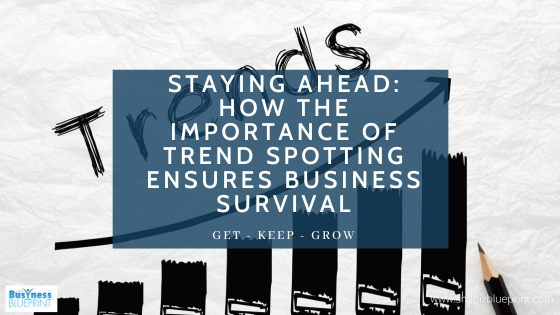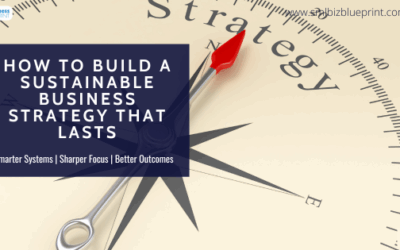As a small business owner, your ability to spot and capitalise on emerging trends can be the difference between thriving and merely surviving.
Trend spotting is not just about staying current; it’s about predicting the future and adapting your business to meet it head-on.
This comprehensive guide will walk you through why trend spotting is crucial for small businesses, how to effectively do it, and how to leverage these insights for growth and sustainability.

Why Trend Spotting is Essential for Small Businesses
In the ever-shifting landscape of the modern marketplace, the ability to identify and act on emerging trends is not just advantageous for small businesses – it’s fundamental for survival and growth.
Here’s why trend spotting is indispensable:
Staying Ahead of the Curve:
In a world where consumer preferences and market dynamics change rapidly, being aware of and responsive to these changes is critical. Trendspotting enables small businesses to stay ahead of these shifts, ensuring they remain relevant and competitive.
Innovation and Product Development:
Small businesses can innovate and develop products or services that meet new market demands by identifying emerging trends. This proactive approach can lead to being a market leader rather than a follower, especially in niches where larger companies might be slower to adapt.
Targeted Marketing Strategies:
Understanding trends allows for more effective and targeted marketing strategies. By knowing what’s in vogue, a business can tailor its marketing efforts to resonate more deeply with its current and potential customers, increasing engagement and conversion rates.
Risk Mitigation:
Trend spotting isn’t just about capitalising on new opportunities; it’s also about risk mitigation. Recognising a declining trend can prevent investing in a dying market or technology, saving resources and pivoting towards more lucrative ventures.
Customer Retention and Satisfaction:
Customers expect businesses to understand their evolving needs. By staying attuned to trends, small businesses can adapt to meet these expectations, enhancing customer satisfaction and loyalty.
Competitive Advantage:
Quickly adapting to and incorporating trends can provide a significant competitive advantage in the competitive business environment. Small businesses often have the agility to pivot faster than larger enterprises, turning trends into opportunities.
Long-term Strategic Planning:
Effective trend spotting informs long-term strategic planning. It helps in anticipating future market developments, guiding where to allocate resources, and shaping the future direction of the business.
Building Brand Relevance and Authority:
Businesses that consistently follow trends are often seen as industry leaders and innovators. This enhances brand reputation, builds authority, and increases trust among consumers and peers.
How to Spot Trends: A Step-by-Step Process
Observation is Key:
Begin by immersing yourself in your industry. Follow influencers, read relevant publications, and engage in industry forums. Remember, trends can surface from any direction.
In-Depth Market Research:
This is the foundation of effective trend spotting. Use quantitative data (like market size, growth rate, and customer demographics) and qualitative insights (like customer opinions and preferences). Resources like IBISWorld, Statista, and Pew Research can provide valuable data.
Customer Feedback and Engagement:
Engage directly with your customers through surveys, social media, and direct feedback. Tools like SurveyMonkey, or even direct customer conversations, can provide insights into their evolving needs and preferences.
Competitive Analysis:
Keep a close watch on your competitors. Tools like Crayon and SpyFu can help you track their moves, understand their strategy, and identify emerging industry trends.
Leverage Tools and Technology:
Utilize tools like Google Trends, social media analytics, and customer feedback platforms. These resources provide tangible data that can spotlight emerging patterns.
Analysing the Data:
This is where the magic happens. Look for patterns and correlations. Is there a sudden spike in specific product demands? What are the new pain points customers are expressing?
Separating the Wheat from the Chaff:
Not every trend is worth pursuing. Evaluate each trend’s potential impact on your business. Is this a short-lived fad or a lasting shift?
Actionable Strategies:
Once you’ve identified a valuable trend, it’s time to act. Develop strategies aligning with these insights, whether tweaking your marketing approach or developing new products.

Leveraging Digital Tools for Effective Trend Spotting
In today’s digital age, having the right tools at your disposal can significantly affect how effectively you spot and respond to emerging trends.
Here, we will delve into various digital tools that are essential for setting up keyword alerts, allowing you to stay informed about relevant industry developments, news, and online conversations.
Google Alerts: The Basic Yet Powerful Tool
Google Alerts is a simple yet powerful way to monitor the web for specific keywords related to your business. You can set up alerts for your business name, industry trends, or competitors.
These alerts will provide real-time emails whenever the specified keywords are mentioned online. To set up, visit the Google Alerts website, enter your keyword, and customise the alert settings to your preference.
Social Media Monitoring: The Pulse of Consumer Sentiment
There are tools for social media monitoring. They allow you to track mentions of your brand or selected keywords across various social media platforms. This is crucial for understanding consumer sentiment and spotting trends as they emerge on social media. These tools often come with advanced features like sentiment analysis and influencer tracking, providing a deeper insight into your social media presence.
Mention: Comprehensive Web and Social Media Monitoring
Mention is a robust tool for real-time monitoring across the web and social media. It goes beyond simple keyword tracking, allowing you to monitor your brand’s online presence. You can track mentions, understand your audience better, and respond to comments or mentions directly through the platform. This tool captures the full scope of discussions surrounding specific trends or topics.
BuzzSumo: Tracking Content Trends and Brand Mentions
BuzzSumo excels in monitoring content trends and brand mentions. It’s an excellent tool for discovering popular content and understanding what topics resonate with your audience. BuzzSumo can alert you when a keyword is mentioned in new content, helping you stay on top of industry news and consumer interests.
Talkwalker Alerts: A Google Alerts Alternative
Talkwalker Alerts offers a more comprehensive alternative to Google Alerts, tracking mentions across the internet, including news, blogs, and forums. This tool can be particularly useful for in-depth monitoring of industry topics or tracking online discussions relevant to your business.
IFTTT for Customized Alerts
IFTTT (If This Then That) enables you to create custom ‘applets’ that connect different web services and set up personalised alerts. For example, you can create an applet to receive a notification whenever your brand is mentioned on Reddit or a specific hashtag is used on Twitter. This tool offers a high level of customisation for your monitoring needs.
Specialised Platforms for Niche Monitoring
For more specialised monitoring, platforms like TrackReddit are perfect for monitoring specific communities like Reddit. Similarly, using Twitter’s Advanced Search feature can help you monitor specific phrases, hashtags, or conversations relevant to your business on Twitter.
Integrating these tools into your trend-spotting strategy ensures your business stays ahead of the curve. Regularly reviewing alerts and insights from these tools will help you make informed decisions, adapt your strategies, and respond to market changes proactively.
Using Google Trends for Small Business Trend Spotting
Accessing Google Trends: Go to Google Trends. There is no need for an account; it’s free and accessible to anyone.
Start with a Broad Search: Enter a broad term related to your industry in the search box. For instance, if you’re in the fashion industry, start with “fashion.”
Refine Your Search: Use the filters to refine your search. You can filter by location, time range, category, and search type (web, news, shopping, etc.). For example, if you’re targeting a specific region, set the location to that area.
Analyse Interest Over Time: The results will show how interest in the term has varied. Look for patterns or spikes in interest. These can indicate emerging trends.
Compare Multiple Terms: Use the “Compare” feature to add and compare interest in different search terms. This can help you gauge relative interest in different aspects of your industry.
Explore Related Topics and Queries: Below the main graph, you’ll find ‘Related Topics’ and ‘Related Queries.’ These sections show related terms that people are searching for. Pay attention to ‘Breakout’ terms, as these queries have significantly increased search frequency.
Geographical Insights: Look at the regional interest section to see where your term is most popular. This can be useful if you’re considering geographic expansion or targeted marketing.
Dive into Subregions and Cities: For more granular insights, drill down into specific subregions or cities. This can reveal local trends that might be relevant to your business.
Use Data for Content Creation: Use insights from Google Trends to create relevant content for your audience. For instance, if you notice an increasing interest in a specific product or topic, consider creating blog posts, social media content, or marketing campaigns around it.
Keep a Regular Check: Make trend spotting a regular activity. Set a schedule to check Google Trends regularly (e.g., weekly or monthly) to stay updated with the latest trends in your industry.
Following these steps, you can effectively use Google Trends to spot emerging trends, understand consumer interests, and make informed decisions for your small business marketing and product development strategies.
Using Feedly for Small Business Trend Spotting
Feedly is an excellent tool for business owners to stay updated with industry news and trends. Here’s a step-by-step guide on how to use Feedly effectively:
Setting Up an Account: Start by visiting Feedly and creating an account. You can sign up using an email address or connect through a Google, Facebook, or Twitter account.
Understanding the Interface: Familiarize yourself with Feedly’s interface. The main areas are the feed section, where your chosen content will appear, and the search and organise functions.
Finding and Adding Sources: Use the search function to find industry-specific blogs, publications, and websites. For instance, if you’re in digital marketing, you might search for ‘digital marketing blogs’ or specific publications like ‘Marketing Week.’
Organising Your Feeds: Once you’ve added several sources, organise them into categories for easy navigation. For instance, create categories like ‘Industry News,’ ‘Competitor Insights,’ or ‘Marketing Tips.’ This helps in quickly accessing relevant information.
Setting Up Keyword Alerts: Use Feedly’s Pro feature to set up keyword alerts. This way, you’ll be notified whenever articles mention key terms relevant to your business. For example, a bakery shop owner might set alerts for ‘artisan bread trends’ or ‘gluten-free baking.’
Leveraging AI Assistance: Take advantage of Feedly’s AI tool, Leo, which prioritises important articles and filters out noise. You can train Leo to recognise what’s most relevant to you.
Integrating with Other Tools: Connect Feedly with other tools like Evernote, OneNote, or Slack for seamless integration into your workflow. This can help share insights with your team or save articles for later reading.
Regularly Reviewing Your Feed: Dedicate time regularly (daily or weekly) to review your Feedly streams. Staying consistent is vital to keeping up with the latest trends and industry news.
Analysing Trends Over Time: Attention to recurring topics or themes in your feed. This can signal emerging trends in your industry that you might capitalise on.
Applying Insights to Your Business: Use the insights from your Feedly reading to inform business decisions. This could range from tweaking your marketing strategy to developing new products or services that align with emerging trends.
Following these steps, a business owner can use Feedly as a powerful tool to stay informed, anticipate industry shifts, and align their business strategies with current trends. Feedly saves time by aggregating content in one place and ensures that you are always in the loop with the latest developments in your field.

Distinguishing Trends from Fads: A Strategic Approach for Business Owners
Once you have identified potential trends using digital tools and keyword alerts, the next crucial step is to analyse them to determine their longevity and relevance to your business.
This section will provide a detailed guide on differentiating a lasting trend from a fleeting fad, ensuring that your business makes strategic decisions based on sustainable market shifts.
Initial Observation and Data Collection
Begin with collecting data on the potential trend. This includes looking at sales figures, customer feedback, and social media analytics to identify any noticeable increase in interest or demand.
Comparing with Historical Data
Analyse historical trends and previous patterns in your industry. This helps understand if the observed pattern is a recurring fad or a potential long-term trend.
Analysing Duration and Consistency
Examine the period over which the trend has developed and its consistency. Sustainable trends typically show a steady pattern over time, unlike fads that spike and quickly diminish.
Evaluating Market Saturation
Assess the current state of the market. If there is a rapid and widespread increase in similar offerings, it might indicate a fad. Actual trends often have a more gradual and sustainable market entry.
Considering the Underlying Factors
Understand the drivers behind the trend. Trends with roots in societal, technological, or economic changes are more likely to endure than those based on transient factors.
Alignment with Consumer Values
Consider if the trend aligns with long-term shifts in consumer values and lifestyles. Trends that resonate with more profound societal changes usually have greater staying power.
Analysing Competitor Responses
Observe how your competitors and the broader industry are reacting to the trend. Widespread industry adoption can be a sign of a lasting trend.
Expert Consultation
Leverage industry experts and market research insights to gain an external perspective on the trend’s sustainability.
Risk-Benefit Analysis
Conduct a thorough analysis of the potential risks and benefits of adopting the trend, considering both short-term and long-term implications.
Testing Before Committing
If feasible, implement a pilot program or a small-scale test to gauge the trend’s effectiveness and reception among your target audience.
Continuous Monitoring
Keep a vigilant eye on the trend, even after initial adoption. Market trends can evolve, and staying updated is crucial for ongoing relevance.
Applying Trend Insights to Your Business Strategy
Once you’ve identified and analysed relevant trends, the crucial next step is integrating these insights into your business strategy. This process is vital for aligning your business with the evolving market and consumer needs.
Here’s how to effectively apply trend insights:
Product and Service Innovation:
Use trend insights to innovate or modify your products and services. For instance, if there’s a growing trend towards sustainability, consider how to make your products more eco-friendly. This not only meets market demand but can also differentiate your brand.
Marketing Strategy Adaptation:
Align your marketing strategies with current trends. For example, if there’s an increasing trend in using social media platforms like TikTok for marketing, consider how to leverage these platforms to reach your target audience more effectively.
Customer Experience Enhancement:
Trends can offer insights into changing customer expectations. Use this knowledge to enhance the customer experience, whether it’s by offering new services, improving customer service channels, or adopting new technologies like chatbots for better engagement.
Supply Chain and Operations Adjustments:
Certain trends might necessitate changes in your supply chain or operational processes. For example, a trend towards local sourcing can lead to a shift in your supplier base, which may benefit your business through reduced costs and enhanced community engagement.
Workforce Development:
Trends in workplace culture, such as remote working or flexible hours, can inform how you manage and develop your workforce. Adopting these practices can lead to increased employee satisfaction and productivity.
Strategic Partnerships and Collaborations:
Some trends might open up opportunities for strategic partnerships or collaborations. For instance, a trend towards health and wellness might prompt a food business to collaborate with fitness centres or health bloggers.
Pricing Strategy Adjustments:
Market trends can impact the perceived value of products or services. Be prepared to adjust your pricing strategies in response to these changes to remain competitive and profitable.
Risk Management and Contingency Planning:
Understanding trends helps anticipate potential market shifts and challenges, allowing for more effective risk management and contingency planning.
Long-term Planning and Investment:
Use trend insights for long-term business planning. This includes making informed decisions about technology, infrastructure, or market expansion investments.
Regular Review and Adaptation:
The market is dynamic, so regularly review and adapt your strategies in response to evolving trends. This ensures your business remains aligned with current market realities and future opportunities.
Applying trend insights to your business strategy is not about a one-time change; it’s an ongoing process of adaptation and growth.
By staying attuned to and incorporating these trends, your business can maintain relevance, satisfy customer needs, and achieve sustainable growth in a competitive marketplace.
Conclusion
Trend spotting is not just a skill; it’s an essential business strategy that separates the leaders from the followers.
By embracing this approach, you ensure that your business remains relevant, responsive, and resilient in the face of change.
Remember, the future favours the prepared. Equip your business with the foresight to meet and exceed customer expectations.
FAQs
Q: How often should I conduct trend analysis for my business?
A: Trend analysis should be an ongoing process. Regularly monitoring industry news and customer feedback can inform you about emerging trends.
Q: Can small businesses compete with larger corporations in trend spotting?
A: Absolutely. Small businesses often have the advantage of agility, allowing them to adapt to trends more quickly than larger corporations.
Q: What are some common mistakes in trend spotting?
A: Common mistakes include ignoring customer feedback, focusing too narrowly on one’s industry, and confusing fads with long-term trends.
Q: How do I differentiate between a fad and a trend?
A: A trend typically has a more prolonged, sustained impact and is often driven by underlying societal or technological changes, whereas a fad is usually short-lived.
Q: How can trend spotting impact my marketing strategy?
A: Trend spotting can guide you to tailor your marketing efforts more effectively, ensuring your messaging resonates with consumer needs and preferences.




